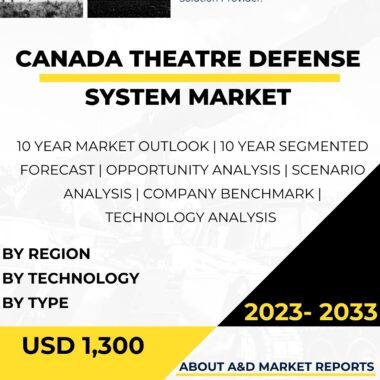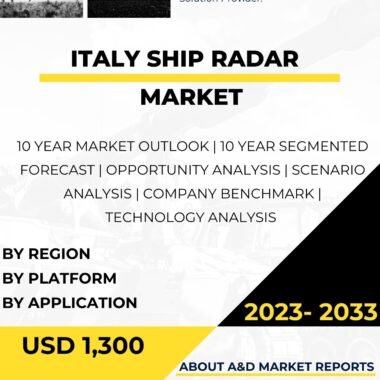Description
The Ship Radar market in Australia plays a pivotal role in the country’s maritime safety, security, and navigation, providing essential capabilities for vessel detection, collision avoidance, weather monitoring, and search and rescue operations. Ship radar systems are vital tools that enable ships to detect other vessels, obstacles, and landmasses, ensuring safe navigation and preventing potential accidents at sea. This article offers a comprehensive overview of the Australia Ship Radar market, including its significance, current applications, major players, technological advancements, government initiatives, civilian applications, and future prospects.
The significance of the Ship Radar market in Australia stems from the country’s extensive coastline, maritime trade, and strategic location. The Australian waters are vast and include various navigational challenges, such as shallow waters, reefs, and unpredictable weather conditions. Ship radar systems are critical in enhancing situational awareness for mariners, allowing them to identify potential hazards, monitor weather patterns, and navigate safely through congested areas and shipping lanes.
In addition to supporting safe navigation, ship radar systems are vital for Australia’s maritime security and defense. Radar technology enables the detection of unauthorized vessels, potential security threats, and suspicious activities, contributing to the country’s efforts in maintaining territorial integrity and maritime sovereignty.
The Australia Ship Radar market encompasses various radar systems designed for different types of vessels and operational requirements. These include navigational radars, which provide ship crews with real-time information about the vessel’s surroundings, including other ships, buoys, and landmasses. Surveillance radars, on the other hand, are used for maritime security and defense purposes, monitoring vessel movements and detecting potential threats in the maritime domain.
The current applications of ship radar systems in Australia include commercial shipping, maritime transport, fisheries, defense, law enforcement, and search and rescue operations. Commercial vessels rely on radar technology for safe navigation and collision avoidance, particularly in busy ports and congested waterways. Maritime transport operators utilize ship radar systems to optimize route planning, monitor weather conditions, and ensure efficient cargo transportation.
Fisheries in Australia utilize ship radar systems for locating fish shoals, monitoring fishing activities, and complying with fishing regulations and maritime boundaries. In the defense sector, radar technology plays a critical role in naval operations, providing early warning of potential threats and enhancing the country’s maritime surveillance capabilities.
The Australia Ship Radar market is served by both domestic and international players. Domestic companies, such as Saab Australia and CEA Technologies, have been instrumental in developing and manufacturing ship radar systems tailored to Australia’s maritime requirements. These companies collaborate with the Australian Defence Force (ADF) and international partners to deliver cutting-edge radar solutions for naval vessels.
International ship radar manufacturers, such as Raytheon, Thales Group, and Kelvin Hughes, also have a presence in the Australian market. These global players provide a wide range of radar systems, radar components, and support services to the Australian maritime industry.
Technological advancements drive innovation in the Australia Ship Radar market. Research and development efforts focus on improving radar resolution, range, sensitivity, and integration with other shipboard systems. The incorporation of digital signal processing and solid-state radar technology enhances radar performance and reliability, allowing for more precise target detection and tracking.
Furthermore, the development of multi-mode and phased-array radar systems enables ships to switch between different radar functions, optimizing radar performance in various operational scenarios.
Looking ahead, the Australia Ship Radar market is expected to witness continued growth and investment. As maritime activities and trade continue to expand, the demand for ship radar systems will increase to ensure safe navigation, maritime security, and defense capabilities.
The adoption of advanced radar technology, such as active electronically scanned array (AESA) radar and radar-based network-centric systems, will further enhance the effectiveness and efficiency of ship radar systems. AESA radar offers improved target detection and tracking capabilities, as well as resistance to jamming and electronic warfare threats.
Network-centric systems enable ships to share radar data with other vessels and shore-based command centers, facilitating cooperative maritime surveillance and improving maritime domain awareness.
The Australian government’s initiatives to enhance maritime safety and security will drive investments in ship radar systems. Initiatives such as the National Plan for Maritime Environmental Emergencies focus on improving the country’s response capabilities to maritime incidents, necessitating advanced radar technology for effective search and rescue operations.
In the civilian sector, ship radar systems will continue to play a crucial role in enhancing maritime safety, supporting fisheries management, and ensuring efficient maritime transport and logistics. The adoption of radar technology in smaller vessels, such as fishing boats and leisure craft, will also contribute to the growth of the Australia Ship Radar market.
In conclusion, the Australia Ship Radar market is of significant importance in ensuring maritime safety, security, and navigation in the country’s vast coastal waters. Ship radar systems enable safe navigation, collision avoidance, and early detection of potential threats, contributing to the protection of lives and the preservation of maritime assets. Domestic and international players contribute to the diverse offerings in the market, driven by technological advancements in radar performance, resolution, and integration. Continued investments in research, development, and international partnerships will be instrumental in maintaining Australia’s credible and effective Ship Radar capabilities. As maritime activities and trade continue to grow, the demand for advanced ship radar systems will remain essential, positioning Australia as a key player in the global Ship Radar market. The adoption of advanced radar technology and network-centric systems will further enhance the effectiveness and efficiency of ship radar systems, driving future developments in the Australia Ship Radar market.




